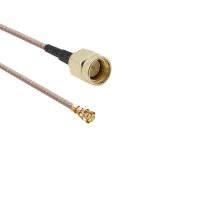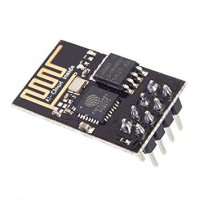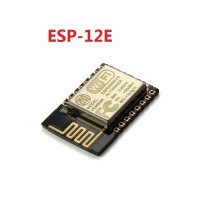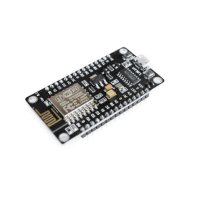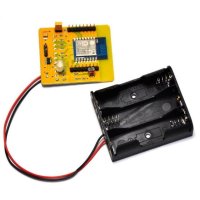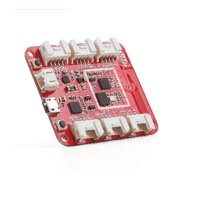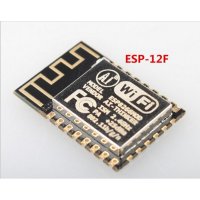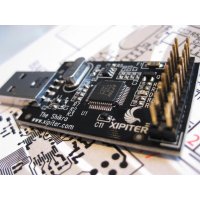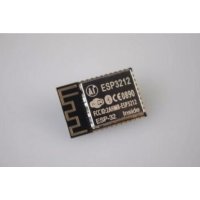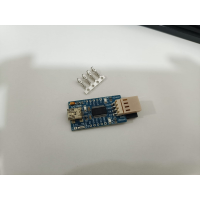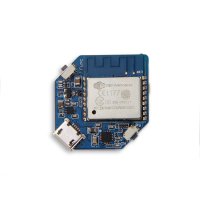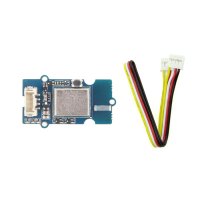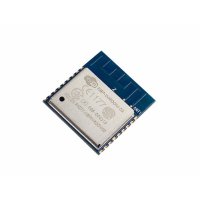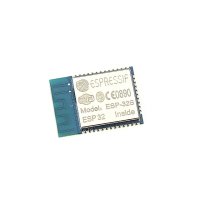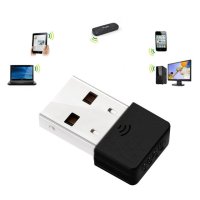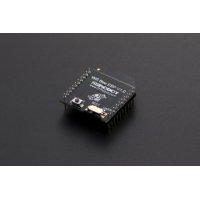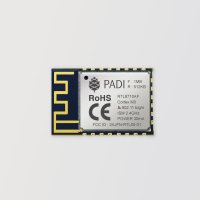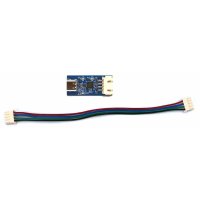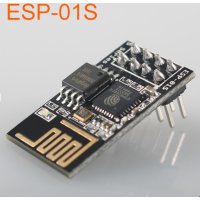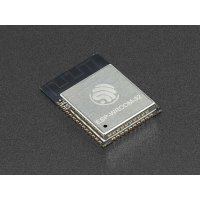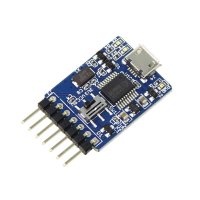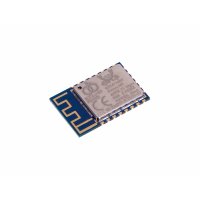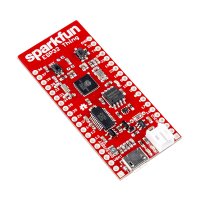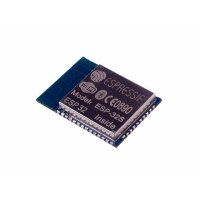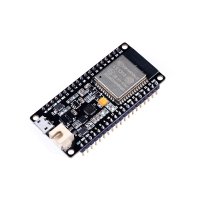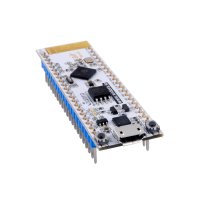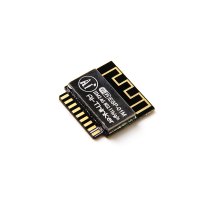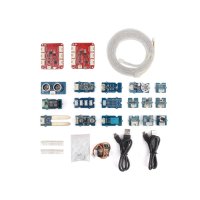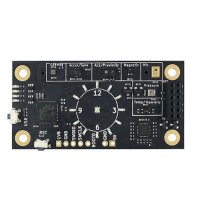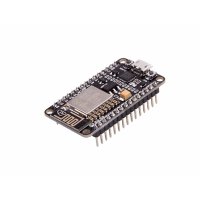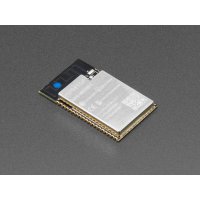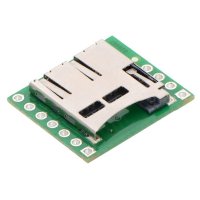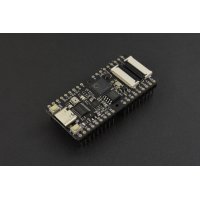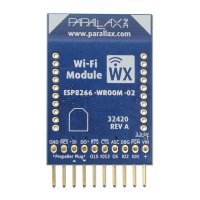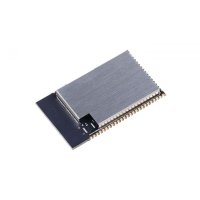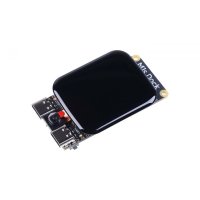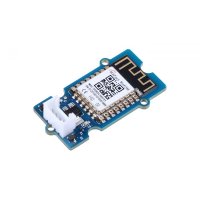This is a breakout board of WiFi serial transceiver module, based on ESP8266 SoC also known as ESP-05
ESP8266 is a highly integrated chip designed for the needs of a new connected world. It offers a complete and self-contained Wi-Fi networking solution, allowing it to either host the application or to offload all Wi-Fi networking functions from another application processor.
ESP8266 has powerful on-board processing and storage capabilities that allow it to be integrated with the sensors and other application specific devices through its GPIOs with minimal development up-front and minimal loading during runtime. Its high degree of on-chip integration allows for minimal external circuitry, and the entire solution, including front-end module, is designed to occupy minimal PCB area.
Corresponding Interface:
- SDIO 2.0, SPI, UART
- 32-pin QFN package
- Integrated RF switch, balun, 24dBm PA, DCXO, and PMU
- Integrated RISC processor, on-chip memory and external memory interfaces
- Integrated MAC/baseband processors
- Quality of Service management
- I2S interface for high fidelity audio applications
- On-chip low-dropout linear regulators for all internal supplies
- Proprietary spurious-free clock generation architecture
- Integrated WEP, TKIP, AES, and WAPI engines
Specification:
- 802.11 b/g/n
- Wi-Fi Direct (P2P), soft-AP
- Integrated TCP/IP protocol stack
- Integrated TR switch, balun, LNA, power amplifier and matching network
- Integrated PLLs, regulators, DCXO and power management units
- +19.5dBm output power in 802.11b mode
- Power down leakage current of <10uA
- Integrated low power 32-bit CPU could be used as application processor
- SDIO 1.1/2.0, SPI, UART
- STBC, 1×1 MIMO, 2×1 MIMO
- A-MPDU & A-MSDU aggregation & 0.4ms guard interval
- Wake up and transmit packets in < 2ms
- Standby power consumption of < 1.0mW (DTIM3)
RF specifications
The following data is at room temperature, the voltage of 3.3V and 1.1V, respectively, when measured
| Description | Min | Typical | Max | Units |
|---|---|---|---|---|
| Input Frequency | 2412 | 2484 | MHz | |
| Input resistance | 50 | Ω | ||
| Input reflection | -10 | dB | ||
| At 72.2Mbps, PA output power | 14 | 15 | 16 | dBm |
| 11b mode, PA output power | 17.5 | 18.5 | 19.5 | dBm |
| Sensitivity | ||||
| CCK, 1Mbps  | -98 | dBm | ||
| CCK, 11Mbps  | -91 | dBm | ||
| 6Mbps (1/2 BPSK)  | -93 | dBm | ||
| 54Mbps (3/4 64-QAM)  | -75 | dBm | ||
| HT20, MCS7 (65Mbps, 72.2Mbps)   | -71 | dBm | ||
| Adjacent suppression | ||||
| OFDM, 6Mbps | 37 | dB | ||
| OFDM, 54Mbps | 21 | dB | ||
| HT20, MCS0 | 37 | dB | ||
| HT20, MCS7 | 20 | dB |
Note: For normal operation, Vcc and CH_PD (chip enable) pins are tied to 3.3V with GND to 0 V, and TX and RX pins connected to your serial interface of choice (Arduino, FTDI USB interface, etc.). As the module operates at 3.3v, if your serial interface operates at 5v, you will need a level converter in the module’s RX line to prevent over-voltage. A simple resistor divider (1kΩ and 2.2kΩ) or resistor and 3.3v zenner will do the trick. For better performance, use a FET level shifter in both RX and TX lines.
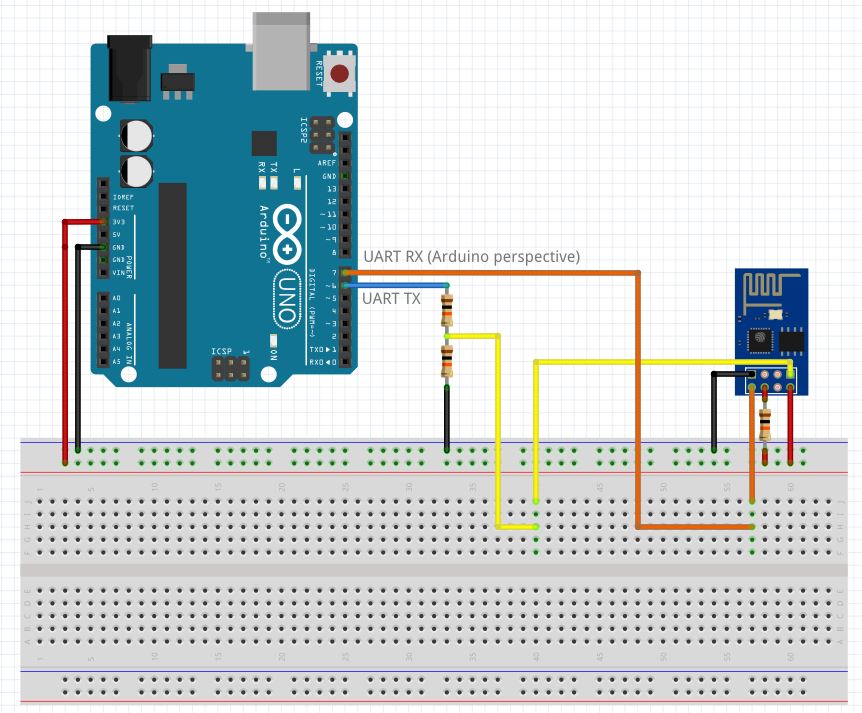
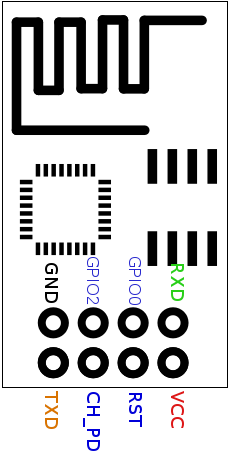
For detailed information on this module visit here
Software: ESP8266 IoT SDK
Sample Codes:
Sample AT Command Test:

WiFi Serial Transceiver Module Breakout Board - ESP8266 ESP-05
- Brand: Espressif Systems
- Product Code: PRC-WiFi-Serial-TxRx-BB-ESP8266-05
- Reward Points: 4
- Availability: In Stock
-
रo 355.00
- Price in reward points: 355
-
- 45 or more रo 352.00
- 85 or more रo 349.00
- 210 or more रo 346.00
- 420 or more रo 344.00
Related Products
UFL/IPX to SMA Female RG178 Pigtail Cable Connector
UFL/IPX to SMA Female RG178 Pigtail Cable Connector. Connects internal WiFi to external WiFi Booster..
रo 135.00
WiFi Serial Transceiver Module - ESP8266 ESP-01 E (1M Flash)
This is WiFi serial transceiver module, based on ESP8266 SoC. The SOC has Integrated TCP/IP protoc..
रo 100.00 रo 260.00
WiFi Serial Transceiver Module - ESP8266 ESP-12E
This is WiFi serial transceiver module, based on ESP8266 SoC. The SOC has Integrated TCP/IP protoc..
रo 302.00
PL2303TA PL2303 PL2303HX USB To UART TTL Cable Module
Designed to be used for USB to TTL electronic projects. Features: Built-..
रo 120.00 रo 240.00
3dBi Standard WiFi Antenna
WiFi 3dBi Standard Antenna. Specificaitons: 2.4 GHz wireless antenna 3 dBi nominal..
रo 211.00
NodeMCU Lua v3 - CH340 CH340G based ESP8266 development Board
This is a new version of NodeMcu Lua WIFI Development Board Not compatible with MAC Features: ..
रo 320.00 रo 450.00
WiFi Serial Transceiver Module - ESP8266 Development Kit
WiFi Serial Transceiver Module - ESP8266 Development Kit Tutorial The password for con..
रo 520.00
Wio Link - Build Your IoT Applications
Wio Link is designed to simplify your IoT development. It is an ESP8266 based open-source Wi-Fi deve..
रo 950.00
WiFi Serial Transceiver Module - ESP8266 ESP-12F
ESP8266-12F is an enhanced version ESP8266-12 with improved peripheral circuits, four plate board te..
रo 250.00
The Shikra
The Shikra is a device that allows the user to interface (via USB) to a number of different low-leve..
रo 6,323.00
WiFi Serial Transceiver Module - ESP32
1. ESP32 integrates the antenna switches, RF balun, power amplifier, low noise receive amplifi..
रo 1,500.00
USB to UART Converter - Cytron
The Cytron USB to UART Converter allows you to connect your computer through USB port and ..
रo 1,850.00
Grove – Uart Wifi
Grove - UART WiFi is a serial transceiver module featuring the ubiquitous ESP8266 IoT SoC. With inte..
रo 1,245.00
Wio Core
Wio Core is developed from ESP-WROOM-02, it is also FCC, CE, KCC, TELEC, LCIE and IC certified with ..
रo 704.00
ESP-32S / ESP-3212 / ESP-WROOM-32 / IoT WiFi Bluetooth module (Superior ESP8266 )
ESP3212 Wifi Bluetooth combo module is ultra high performance and ultra low-power consumption ..
रo 1,010.00
Wifi + Bluetooth USB Mini Wireless Dongle
Wifi + Bluetooth Duo USB Mini Wireless Dongle Features: Support standards and protocols ..
रo 980.00
ESP8266 Wifi Bee (Arduino Compatible)
Wifi Bee-ESP8266 is a Serial-to-WIFI module using XBEE design in a compact size, compatible with XBE..
रo 568.00 रo 654.00
Pine64 PADI IoT Stamp
PADI IoT Stamp Features Low cost highly integrated solution for wireless IoT devices ..
रo 286.00
USB-UART 2 Module Kit
The major change of the USB-UART2 Kit is a Type-C Connector from Micro-USB.Note! This product comes ..
रo 1,302.00
WiFi Serial Transceiver Module - ESP8266 ESP-01 S (1M Flash)
This is WiFi serial transceiver module, based on ESP8266 SoC. The SOC has Integrated TCP/IP protoc..
रo 291.00
Adafruit 3320 ESP32 WiFi-BT-BLE MCU Module / ESP-WROOM-32
The ESP8266 started a small revolution by bringing WiFi to a small and cheap package that also had e..
रo 966.00
USB To Uart 5V&3V3
USB To Uart 5V/3V3 is a USB to serial adapter,Which is base on CH340,CH340 is a USB bus convert chip..
रo 951.00
RTL8710 WiFi Module
RTL8710 Wifi Module is a low-cost wireless IoT platform based on Realtek RTL8710 ARM Cortex-M3 Proce..
रo 415.00
ESP32 Thing for Internet
ESP32 Thing for Internet The ESP32 Thing is a comprehensive development platform for Espressif’..
रo 2,485.00
ESP32S Wifi Bluetooth Combo Module
ESP-32S Wifi Bluetooth combo module is ultra high performance and ultra low-power consumption Wi-Fi ..
रo 396.00
ESP32 Development Board
GeeekNET ESP32 Development Board is made with the official WROOM32 module. There is built in USB-to-..
रo 2,527.00
Widora AIR Based ESP32 Development Board
AIR hardware platform based on ESP32 microcontroller, onboard 4MByte FLASH and peripheral circuits, ..
रo 1,846.00
ESP8285 Wi-Fi SoC Module
ESP-01M can be widely used in various occasions for networking, home automation, industrial wireless..
रo 332.00
FireBeetle ESP32 IOT Microcontroller (Supports Wi-Fi and Bluetooth)
FireBeetle series is the low-power consumption micro-controller intentionally designed for Internet ..
रo 997.00 रo 1,149.00
Wio Link Deluxe Plus Kit
This kit is same with Wio Link Deluxe Kit /Deluxe Kit except this kit contain another two display mo..
रo 20,966.00
96Boards Linaro Neonkey
Item Specifications: Brand Name : TOCODING Compatibitlity : Others Model Number : TSH100..
रo 4,820.00
NodeMCU Lua v2 ESP-12E CP2102 based ESP8266 development Board
NodeMCU CP2102 The NodeMCU is an open-source firmware and development kit that helps you to prot..
रo 320.00
Adafruit 3979 ESP32-WROVER-B Module - ESP32 with PSRAM Module
The ESP8266 started a small revolution by bringing WiFi to a small and cheap package that also had e..
रo 1,074.00
Pololu 2597 Breakout Board for microSD Card
MicroSD memory cards (originally known as TransFlash) provide a compact and inexpensive way to add g..
रo 264.00 रo 275.00
Maix Bit AI Development Board RISC-V K210 IOT
Maix Bit AI development board adopts AI chip K210 of RISC-V kernel. K210 comes with dual-core proces..
रo 2,498.00 रo 2,879.00
Parallax 32420S / 32420D WX ESP8266 WiFi Module
The Parallax WX ESP8266 Wi-Fi module adds a new dimension of connectivity to your microcontroller ap..
रo 3,256.00
Sipeed BL808 M1s Module with WIFI / BT / BLE
Sipeed M1s Module is an AIOT module based on BL808 of Bouffalo Lab, it contains 3 cores inside, with..
रo 915.00
Sipeed M1s Dock AI Development Broad with 1.69 Inch CTP Screen,WiFi/BT/BLE/wireless module
Sipeed M1s Dock is a development board designed based on Sipeed BL808 M1s Module, routes interface l..
रo 2,519.00
Grove UART WizFi360
Grove UART WizFi360 is based on Wiznet's wizfi360 Wi-Fi module, which is a cost-effective WiFi modul..
रo 1,393.00
Tags: RF, Serial, Transceiver, Module, WiFi, ESP8266, Breakout, Board

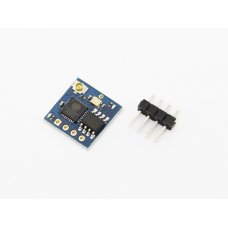

%20-%20ESP8266-74x74.jpg)
%20-%20ESP8266-74x74.jpg)
%20-%20ESP8266-74x74.jpg)
